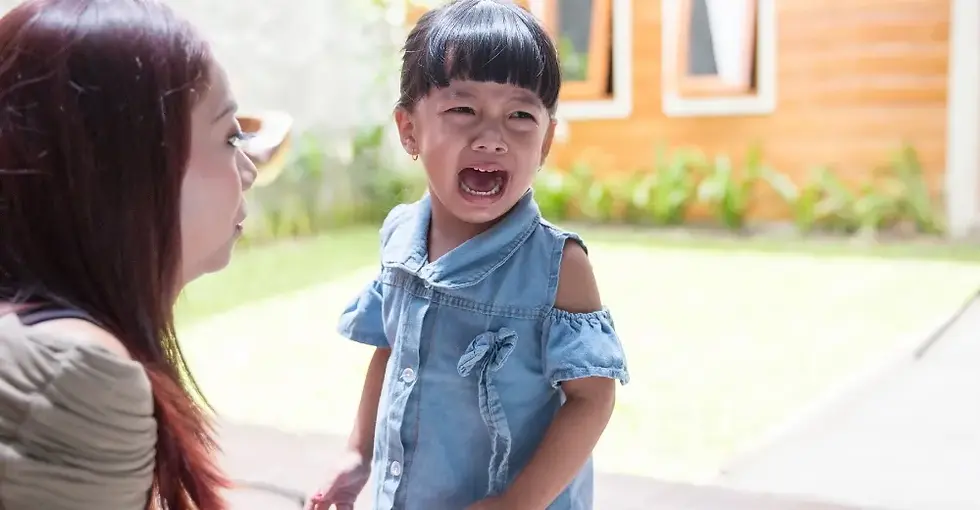4 Steps to Managing Aggressive Behaviors in Your Toddler
- Lauren Fallat, LPC LPAT ATR-BC

- Aug 25, 2022
- 3 min read
Updated: Sep 8

4 Steps to Managing Aggressive Behaviors in Your Toddler: Biting, Hitting, Pushing and Kicking
Toddlers are full of energy and intense emotions and often as caregivers and parents we are navigating the best ways to harness this energy and help in regulating these large emotions.
They are continuously learning how to respond to and express these emotions outwardly. Toddlers do not always have the words to verbally express their wants and needs, let alone identify how they are feeling.
Often toddlers will use body language and nonverbal cues to communicate, sometimes this leads to aggressive behavior. And as caregivers, we are tasked with providing a safe space for the child to appropriately express these emotions, begin to identify them and model effective and prosocial ways to do so.
Observe Your Toddler
Often when we observe a toddler’s behavior, it can give us information about an emotional or physical need that they have.
These emotional needs might be for closeness, attention, interaction, praise, touch/physical affection, love, understanding, safe boundaries, trust, autonomy, validation or quality time. Physical needs might include hunger, thirst, or internal pains, like gas, nausea or body aches.
What to Do:
1. Set limits in a specific and clear way.
Identify what behavior you are wanting to change and in what circumstances that behavior is not acceptable or appropriate. It is important to acknowledge that behaviors, such as biting, kicking and pushing are not innately ‘bad’ or ‘wrong’ behaviors.
What you child is learning is that pushing in certain circumstances cannot happen. Also, remember in setting a boundary, it is important that you are firm, but not shameful or sharp in your tone and delivery, but more matter-of-fact.
Example:
“No hitting me.” “No hitting your friend.” “No hitting your teacher.”
2. Offer an Alternative.
After communicating the boundary, it is important that you then express to your toddler what is an appropriate and positive alternative to direct their behavior.
Example:
After we have set the limit, “No hitting Mommy”, you can follow up with “What can we hit? Yes, we can hit the floor.” (demonstrate appropriate hitting of the floor, kicking of the ball, clapping hands, etc.)
Alternatives for:
hitting: floor, grass, carpet, couch, pillow, table top, clapping hands together, ball with a bat
kicking: soccer ball or other type of ball on the ground, stomping the ground, balloons on the ground
biting: food, teething toy or stuffed animal
pushing: shopping cart, stroller, wagon, laundry basket, chair under the table, heavy box
3. Reinforce the Appropriate Behaviors.
Reinforce your child exhibiting the appropriate timing for a certain behavior and in the appropriate context.
Also, use this as a chance to recall boundaries around the behavior by catching the child doing something well, while reminding them of the limits for when it is not appropriate.
Example: You notice your child hitting the ground when you notice they are frustrated or kicking a soccer ball around the room or biting into their food.
You can say:
“Look at you, biting down on your food with your strong teeth. Yes, biting your food is what you can do. Remember what we cannot bite. No biting our friends.”
4. Attention-to as Prevention-from.
It is important to attune yourself to your child’s needs in a moment and recognize moments when they might typically engage in a certain behavior.
If you notice their frustration increasing or their body language shifting you can present the boundary and remind them of the alternative.
Example:
“Uh, uh no hitting mommy. Remember what you can hit. Yes, you can hit the floor or clap your hands.”
Remember that this approach takes time and patience as your child continues to navigate their emotions as well as respond to your body language and words.
Schedule an Appointment
To schedule an appointment, click on the Book Now button and there you will see our availability for the next two months. You can select the day and appointment time that works best for you.
We look forward to meeting you and will do our very best to be of assistance.
To learn more: About Us
Please visit our Art therapy website to learn about this transformative therapy that we also offer to interested clients: https://www.arttherapynj.com/



